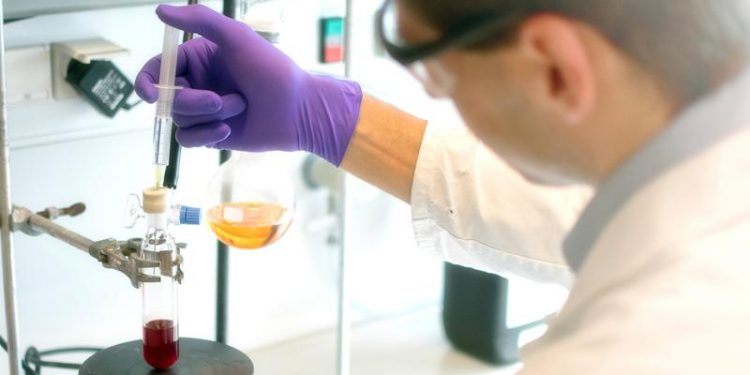New method for quicker and simpler production of lipidated proteins

In the Journal of the American Chemical Society, researchers from Graz University of Technology and University of Vienna present a new method for the production of lipid proteins © TU Graz/ORGC
Some of the body’s proteins are not just made up of amino acids, they are also ‘decorated’ with lipid chains, which significantly influence the biological functions of the protein.
An example is the Ras protein, which plays a role in the development of many types of cancers and is only active and cancer-causing if it is able to bind to the cell membrane with the help of a ‘lipid anchor’.
Fundamental research as a basis for medical progress
Gaining a better understanding of these processes in the human body can greatly accelerate the development of new medicines and cancer therapies. However, the methods of investigation employed up to now have proven very time-consuming and costly. Rolf Breinbauer from TU Graz’s Institute of Organic Chemistry and Christian Becker from the Institute of Biological Chemistry at the University of Vienna have come up with a much simpler and direct method of introducing lipids into protein, which they recently published in the Journal of the American Chemical Society (JACS).
A noble metal for protein modification
The researchers used the noble metal palladium as a catalyst for attaching lipids to proteins. BIPHEPHOS a type of ligand, plays a crucial role in the process, explains Breinbauer: “We tested a total of 50 different ligands. BIPHEPHOS was kind of the ‘missing link’. It has the selectivity needed for palladium to facilitate the lipidation of the sulphurous amino acid cysteine.”
Protein chemist Christian Becker applied what they had learned to proteins, with equally successful results: “The outstanding selectivity of the new catalyst and the robust reaction facilitate the rapid modification of numerous cysteine-containing peptides and proteins for use in biomedical research.”
Medical application
Decorating proteins with pharmaceuticals and other molecules for targeted delivery into the body and for keeping them active is an approach commonly used in medicine today. The method developed by Breinbauer and Becker could now be used to accurately and efficiently introduce such molecules into proteins. Breinbauer is confident that their method will soon be adopted because “the reagents we used are very easy to manufacture or can be purchased.”
Original publication: https://pubs.acs.org/doi/10.1021/jacs.9b08279
This research project is a stand-alone project funded by the Austrian Science Fund (FWF) and is part of the Human & Biotechnology Field of Expertise (FoE), one of five research focuses at TU Graz, as well as the Biology and Medical Chemistry research focus of the Faculty of Chemistry at the University of Vienna.
TU Graz contact
Prof. Rolf Breinbauer
Institute of Organic Chemistry | TU Graz
Tel. +43 (0)316 87332400
E-mail: breinbauer@tugraz.at
orgc.tugraz.at
University of Vienna contact
Prof. Christian F.W. Becker
Institute of Biological Chemistry | University of Vienna
Tel. +43 (0)1 427770510
christian.becker@univie.ac.at
https://pubs.acs.org/doi/10.1021/jacs.9b08279
https://www.tugraz.at/institute/orgc/home/ (Institute of Organic Chemistry | TU Graz)
https://biologischechemie.univie.ac.at/en/ (Institute of Biological Chemistry | University of Vienna)
Media Contact
All latest news from the category: Life Sciences and Chemistry
Articles and reports from the Life Sciences and chemistry area deal with applied and basic research into modern biology, chemistry and human medicine.
Valuable information can be found on a range of life sciences fields including bacteriology, biochemistry, bionics, bioinformatics, biophysics, biotechnology, genetics, geobotany, human biology, marine biology, microbiology, molecular biology, cellular biology, zoology, bioinorganic chemistry, microchemistry and environmental chemistry.
Newest articles

NASA: Mystery of life’s handedness deepens
The mystery of why life uses molecules with specific orientations has deepened with a NASA-funded discovery that RNA — a key molecule thought to have potentially held the instructions for…

What are the effects of historic lithium mining on water quality?
Study reveals low levels of common contaminants but high levels of other elements in waters associated with an abandoned lithium mine. Lithium ore and mining waste from a historic lithium…

Quantum-inspired design boosts efficiency of heat-to-electricity conversion
Rice engineers take unconventional route to improving thermophotovoltaic systems. Researchers at Rice University have found a new way to improve a key element of thermophotovoltaic (TPV) systems, which convert heat…



